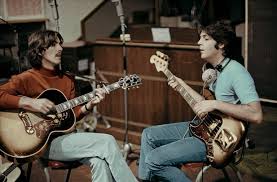Creative Friction and Mutual Respect: Inside Paul McCartney and Eric Clapton’s Subtle Clash During the Beatles Era……
Though Paul McCartney and Eric Clapton have long stood as towering figures in rock history, their musical journeys—while often intersecting—were marked by subtle creative friction that began during a pivotal moment in the late 1960s. Their contrasting approaches to music came into sharper focus during the recording of “While My Guitar Gently Weeps”, a landmark Beatles track that marked one of the rare instances when a non-Beatle entered the band’s inner sanctum.
The invitation extended to Clapton came not from McCartney or Lennon, but from George Harrison, the often-underappreciated third pillar of the Beatles’ songwriting triangle. Frustrated by what he felt was a lack of enthusiasm from his bandmates for the song, Harrison took the unusual step of bringing in Clapton to add emotional weight to the track. At the time, Clapton was already revered as a blues virtuoso, known for his searing solos and expressive playing style. His presence was both unexpected and unprecedented in the Beatles’ insular creative process.
Paul McCartney reportedly greeted the decision with some skepticism. The Beatles prided themselves on being a self-contained unit, one where every part—writing, playing, producing—was kept within the group’s walls. Clapton’s involvement, while welcome to Harrison, subtly challenged that unity. McCartney, a meticulous craftsman and musical perfectionist, had a deep appreciation for control and structure. Bringing in an outsider, even one as respected as Clapton, disrupted that balance.
But something remarkable happened when Clapton walked into the studio. According to those present, the atmosphere instantly shifted. The tension that had begun to define the Beatles’ later sessions gave way to a more respectful, focused energy. With an outsider watching, egos temporarily took a backseat. The band played better, more attentively. Clapton’s now-legendary solo, enhanced by a slight vari-speed effect to blend more seamlessly into the Beatles’ sonic world, became one of the defining features of the song—and a moment of quiet triumph for George.
Despite the success of the collaboration, the philosophical differences between McCartney and Clapton remained evident over the years. While Clapton continued to pursue blues-based authenticity—often favoring rawness and feel over polish—McCartney leaned further into melody, harmony, and orchestration. He saw pop and rock as vehicles for expansive, sometimes symphonic ideas, while Clapton, even at his most experimental, sought to remain grounded in the emotive simplicity of the blues.
The two legends would reunite on several occasions, notably during Concert for George in 2002, where they honored Harrison’s legacy together. Clapton led the musical direction of the event, and McCartney performed both Beatles and solo-era songs. Their chemistry onstage was genuine, fueled by respect more than friendship, and certainly more than rivalry.
In an interview reflecting on his time with the Beatles and his collaborations with McCartney, Clapton once remarked, “Paul is intensely gifted but very organized. We approach music from different directions.” That comment—understated and characteristically British—hinted at a creative divergence that never devolved into hostility, but always carried a subtle edge.
Today, their legacy is cemented not just by their hits, but by the moments where their paths crossed. “While My Guitar Gently Weeps” remains a testament to the power of artistic collaboration—even when it comes with tension. And for fans, it’s a reminder that sometimes, genius thrives not in perfect harmony, but in the delicate balance of creative friction.
